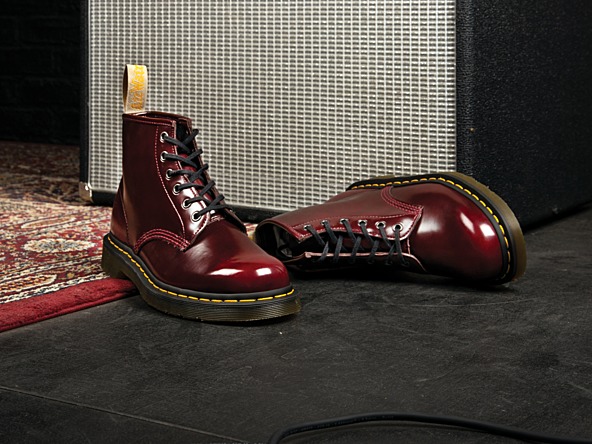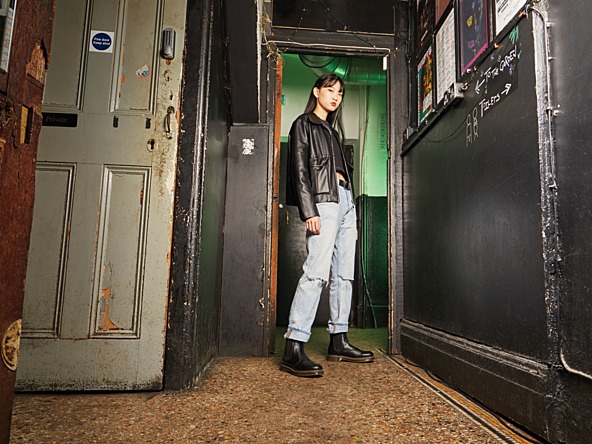FEATURE25 February 2021
Best foot forward: How Dr Martens is stepping into the future
x Sponsored content on Research Live and in Impact magazine is editorially independent.
Find out more about advertising and sponsorship.
FEATURE25 February 2021
x Sponsored content on Research Live and in Impact magazine is editorially independent.
Find out more about advertising and sponsorship.
Dr Martens has a long history of identification with subcultures, but insight is helping the brand to keep its solid footing for the future. By Liam Kay

Whether it’s a punk pogoing at a gig, a goth striding into a local bar or a guitarist stepping out on stage, Dr Martens has been a staple footwear of many subcultures in the UK in recent decades. The iconic brand celebrated its 60th birthday last year, and continues to be a prominent presence on today’s high street.
Despite its unique look and devoted fanbase, Dr Martens is always looking to stay relevant for a new audience, and insights and market research help keep it on the front foot.
Michelle Faure, head of brand strategy and insights at Dr Martens, leads the company’s insight function. She heads up a team of two others, including a strategy director who sits on the company’s global leadership team.
The team has not always had insight in its remit – it adopted the discipline 18 months ago, after a request from the company’s chief executive, having previously been focused solely on strategy. “We used to do a bit of consumer research within our marketing department, but there wasn’t an all-seeing insight function,” says Faure.
“Starting life as pure strategy meant we circumvented many of the issues I hear so often from counterparts in other businesses, such as struggling to embed insights into the organisation or to get time with senior stakeholders.
“For us it’s the total opposite. Because we, alongside other functions, get to set the ‘question’ and then answer it, we are very clear on our priorities – we know exactly the impact it is going to have and we don’t struggle to push anything through.”
The challenge has been building a foundation of knowledge on which to base future strategy. This is a big task, says Faure, but the team is small, agile, and has the backing to do it.
The team works closely together and with different functions across the company, particularly the chief product and marketing officer, the global leadership team, and the marketing and product departments.
“We rarely do anything in isolation,” Faure says. “Designing projects and answering the questions we want to answer will always be done hand in hand with the other main department we are working with. We run the project with them, co-create the answer, and work with them through the implementation. We have this unofficial extended team that goes throughout the business.”

As a consequence of its origins as a strategy department, the insight team is primarily focused on the medium to long term – hence the focus on building a knowledge base to understand the current status quo in retail and fashion. This is used to inform major strategic decisions, as well as how consumers perceive Dr Martens.
The first big project is focused on renewing the brand definition, including Dr Martens’ purpose, values, the causes it supports, its target customers and how it communicates.
“For a company that has been around 60 years, it is quite a scary prospect,” admits Faure. “Rocking the boat with a brand that means so much to so many people feels monumental. It feels poetic that we are doing this on our 60th birthday.”
This refresh of the brand definition includes being more willing to showcase its alternative values and speak up on important world issues, according to Faure.
“It is no longer OK to be that passive brand that says ‘we do the boots, you do the rest’. We need to show up to the party.”
Adopting values is the easy part – embedding them in the company’s culture is a different matter. Faure explains that the insights and strategy department wants to avoid becoming a “bottleneck” for information, so it has created a user-friendly dashboard to make that desire a reality and to make data accessible across the company.
Produced internally, the dashboard is updated quarterly and can be viewed by everyone. It contains all the company’s insight data, including consumer profiles, surveys from 14 markets and people’s views of rival brands.
To promote the dashboard, a roadshow took place across every department to show them how to use it and interpret the information available. More than 100 hours were spent in the workshops, which were mainly held online because of Covid-19. Follow-up workshops will be held annually.
“That was a dramatic shift for everyone, no matter what department you are in, to have access to that data,” Faure says. “We are not precious about sharing data. Only good things can come from everyone having a bit more knowledge. People can have conversations about insight now as we have taken the time to do something thoroughly and well. Sometimes, we have to remind ourselves how lucky we are to be starting a department from scratch, as you can design it how you want.”
Once the work on brand definition – which is being done in partnership with cultural insight agency Sign Salad (see boxout below) – is complete, the focus will be on segmenting the company’s customers and distribution channels. The hope is for the business to use this segmentation as a springboard to be bolder – for example, ensuring stores are able to meet customer expectations.

Dr Martens also works with several external insights and research agencies, including with its panel provider Toluna on a quarterly survey, with Select Statistics on consumer segmentation, and with UM on marketing.
In addition, the team runs a lot of one-off projects with agencies. The company is working with Simon-Kucher & Partners on pricing, featuring a survey and qualitative focus groups to understand consumer opinions on value for money and price limitations.
Savanta, meanwhile, is working on a project looking at the brand’s in-store experience, which has led to alterations to how products are showcased on the high street. The research focused on Dr Martens stores in Japan, the UK and the US using a mix of conscious and non-conscious techniques – including observation and exit surveys.
Cultural consultancy Loud has worked with Dr Martens on a project around cultural consciousness, and studied the growth paradox, whereby companies try to retain their original values as they widen their appeal. This resulted in a ‘boot room’ being built within Dr Martens’ flagship store in Camden, London, which produces experiences, videos and audio to engage a range of local and global communities, and to feed into Dr Martens’ campaigns.
There is also the ongoing project with Sign Salad, to evolve the company’s branding and ‘rebellious’ image (see boxout, below).
Faure says there is pressure on the company from its traditional fanbase – particularly with such a distinctive product – and the desire to keep the brand moving forwards into the future.
“It is a challenge, in that people are so passionate about this brand, internally and externally,” she says. “There’s a lot of pressure to not mess with the gem.
“Equally, it is really important that we make sure the brand is still standing for what it stood for, but in a way that is relevant and meaningful in today’s climate. It is trying to bring the magic of the past into something that’s meaningful today.”
The decline in music subcultures poses both a threat and an opportunity. Whereas Dr Martens was once – and still is – beloved of alternative music scenes, such as punk or grunge, today’s music industry is much less homogenous. It remains a household name, however – which has been helpful in maintaining sales and brand presence during Covid-19 – and it is seeking to tap into a younger generation more willing to experiment with their style.
“In really scary times, people return to the brands they know and love – the brands that have heritage and evoke feelings of nostalgia,” Faure says. “Subcultures today are not what they used to be – they barely exist because of the fluidity in how people express themselves. I might dress like a punk one day and dress in a suit the next, and that’s OK. My expression is not boxed up.”

Dr Martens’ work on brand definition was done in partnership with semiotics and cultural insight agency Sign Salad. It conducted a semiotic analysis of Dr Martens’ branding and culture of “rebellious self-expression”. The reason for doing this, Faure says, was to see if the term resonated with today’s consumers in the same way that it has with previous generations.
“We have this incredible history, heritage and past, and subcultures really put our brand on the radar and made it what it is today,” she says. “That is something that should be celebrated, but our brand is so much more than that. The work we are doing around our brand definition will help to articulate who the consumers are we want to target.”
Sign Salad visited the UK, the US and Japan to explore bookstores, recreation spaces and cultural institutions, as well as drinking and eating establishments. It analysed advertising, packaging and products to decode how rebellious self-expression is constructed across cultures.
The results identified residual (past), dominant (mainstream) and emergent (future-facing) cultural codes, together with the visual and linguistic cues of each. Sign Salad defined what ‘rebelliousness’, ‘the self’ and ‘self-expression’ meant today, and mapped out the codes into which Dr Martens fits.
Cultural consciousness has been a priority for the company since the research, and giving teams a common language and frameworks through which to describe and analyse their work. This has been adapted for new Dr Martens projects and concepts – for example, genderless store layouts are being trialled in a few locations, while the company is looking at how ‘rebelliousness’ can be discussed in China in a way that is authentic to the brand and local market.
This article was first published in the January 2021 issue of Impact.
0 Comments